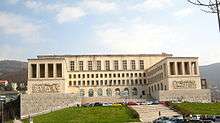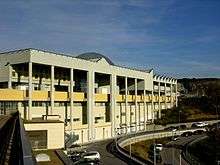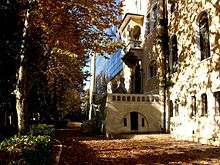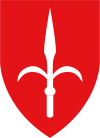University of Trieste
| Università degli Studi di Trieste | |
 | |
| Type | Public |
|---|---|
| Established | 1924 |
| Rector | Prof. Maurizio Fermeglia |
Administrative staff | 1,000 |
| Students | 20000[1] |
| Location | Trieste, Italy |
| Sports teams | CUS Trieste |
| Affiliations | Almalaurea, CEI University Network, Nettuno (accessed 26 February 2014) |
| Website | www.units.it |
The University of Trieste (Italian: Università degli Studi di Trieste, or UNITS) is a medium-sized university in Trieste in the Friuli-Venezia Giulia region in northwest Italy. The university consists of 12 faculties, boasts a wide and almost complete range of university courses and has about 23,000 students and 1,000 professors. It was founded in 1924.
The historical international vocation of the University of Trieste is witnessed by its intense and high-level activity: Trieste is the centre of many research facilities, with which the University is connected by cooperation agreements. Among them, there are the International School for Advanced Studies, the International Centre for Theoretical Physics, the National Institute of Oceanography, the International Centre for Genetic Engineering and Biotechnology, the Elettra Sincrotrone Trieste Facility, the Trieste sections of the Italian National Institute for Nuclear Physics (INFN) and Italian National Institute for Astrophysics (INAF), and many others, building up the so-called "sistema Trieste" (Trieste System).
Moreover, the number of international inter-university co-operation agreements rapidly increased these last years. These agreements involve staff and student mobility, both within EU Programmes like the Socrates programme and agreements exclusively concerned with research activities.
In 2009, in the Il Sole 24 Ore National University Ranking, University of Trieste was ranked the second best university in Italy.[2] Moreover, in 2014, it was evaluated the second best Italian university by the Times Higher Education World University Rankings and the 201st worldwide.[3]
History

Before World War I, when Trieste was still a part of the Austro-Hungarian Empire, the Italian-speaking population strongly supported the idea of building a university in the town, but Austrian authorities repeatedly rejected the proposal. After the annexation of Trieste to Italy, the already existing Superior School in Commerce was granted the same rights of similar schools in Italy, and in 1924 it was turned into a university, by king's decree (8 August 1924, n. 1338). In 1938, with the institution of the Law faculty, the second after the Economy and Commerce faculty, the University became a Studium Generale (General Studies) one, and thus was given the title of Regia Università degli Studi (King's University). In the same year, the construction of a new building to house the faculties began on the Scoglietto hill, in a position dominating the Old City. The building, which still hosts the directive board and some faculties, was designed by architects Raffaello Fagnoni and Umberto Nordio. The first stone was posed in a ceremony on 19 September 1938 in the presence of the Italian Prime Minister and other authorities.
World War II slowed down the planned enlargement of the University. Indeed, the faculty of Engineering, although established in 1942, was restricted to naval engineering until the end of the war, while the opening of the faculty of Literature and philosophy, planned in 1943, was postponed till 1945. After the war, Trieste was put under the joint control of the United Kingdom and the United States of America, in preparation for the establishment of a fully independent State, the Free Territory of Trieste, which nevertheless never came to exist. The Allied Government allowed the foundation of the new Literature and Philosophy faculty, instituted the faculty of Mathematical, Physical and Natural Sciences, and completed the construction of the main building on the Scoglietto hill, inviting an emissary of the Italian government to the inauguration ceremony.
In 1954 Trieste was given back to Italy thanks to an agreement between the American and the Italian governments. To celebrate, the University awarded the President of the Italian Republic Luigi Einaudi a honoris causa degree in Economy and Commerce. In a short time new faculties were added (Pharmacy, Teaching Sciences, Medicine and Surgery, Political Sciences), while also new buildings were inaugurated on the Scoglietto hill and in other parts of the town. In 1978 the School of Modern Languages for Interpreters and Translators was given the status of faculty; in 1997 the faculty of Psychology and in 1998 the faculty of Architecture completed the range of faculties currently present at the University.
Organization

These are the 10 departments into which the university is divided on the basis of the major reorganisation of the university's academic structure which took place in 2010:
- Department of Chemical and Pharmaceutical Sciences
- Department of Economic, Business, Mathematical and Statistical Sciences
- Department of Engineering and Architecture
- Department of Humanities
- Department of Legal, Language, Interpreting and Translation Studies
- Department of Life Sciences
- Department of Mathematics and Geosciences
- Department of Medicine, Surgery and Health Sciences
- Department of Physics
- Department of Political and Social Sciences
A Language Centre was established as an independent service on 1 January 2003. The Centre provides fundamental support in the following areas: organisation and running of taught language courses in all the Faculties of Trieste University; organisation of Italian courses (beginner, intermediate and advanced level) for Socrates students both going abroad and coming to Trieste.
Structures

The main Campus is centered on the building in Piazzale Europa, on the Scoglietto hill, housing the Rector's office, the Administration offices, the Main Library and the faculties of Law and Political Sciences. Other buildings in the campus host the faculties of Economics, Pharmacy, Mathematical, Physical and Natural Sciences, Engineering, the Medical Institutes of Microbiology and Physiology, the towing tank, the Data Processing Centre, the Department of Chemical Sciences and the Department of Biochemistry, Biophysics and Macromolecular Chemistry. Within the premises are also sited the university canteen and three Students' hostels, run by the Agenzia Regionale per il Diritto agli studi superiori – ARDISS – (Regional Organization for the Right to University Study).

Other departments are located in different parts of the town; for example, the Department of Geological Sciences and the Department of Earth Sciences are accommodated in the buildings of the former psychiatric hospital, not far away from the main campus, inside San Giovanni Park.
The old buildings of Via dell'Università and Via del Lazzaretto vecchio, in the heart of the city near the seafront, house the Department of Humanities.
The Faculty of Medicine and Surgery is located in several university compounds, particularly in structures annexed to the three town hospitals: Cattinara, Ospedale Maggiore, Burlo Garofolo.

Far from the city centre, near the ICTP (International Centre for Theoretical Physics) there is the Department of Theoretical Physics, in the village of Miramare-Grignano, while the Department of Astronomy is housed near Trieste's two Astronomical Observatories: on San Vito hill and on the karst plateau, in Basovizza.
A few faculties are not in Trieste, but in other cities of the Friuli Venezia Giulia region and in the neighboring Veneto region. Particularly, in the Pordenone campus, there are undergraduate and graduate programs in Engineering and Education, while the Gorizia campus offers undergraduate and graduate degree programs in International and Diplomatic Studies (part of the Faculty of Political Sciences) and three first-level degree: Business communication and human resource management, Economics and tourism management, Territorial policy. Finally, the Portogruaro campus in the Veneto region hosts the Teaching Sciences Department.
List of Departments
- Department of Architectural and Urban Design
- Department of Astronomy
- Department of Biochemistry, Biophysics and Macromolecular Chemistry
- Department of Biology
- Department of Biomedical Sciences
- Department of Chemical Sciences
- Department of Chemical, Environmental and Raw Materials Engineering
- Department of Civil and Environmental Engineering
- Department of Earth Sciences
- Department of Economics and Statistics
- Department of Education
- Department of Electric, Electronic and Information Engineering
- Department of Geological, Environmental and Marine Sciences
- Department of History and Art History
- Department of Human Sciences
- Department of Law
- Department of Materials Science and Natural Resources
- Department of Mathematics and Informatics
- Department of Mechanical Engineering
- Department of Naval Architecture, Ocean and Environmental Engineering
- Department of Pharmaceutical Sciences
- Department of Philosophy
- Department of Physics
- Department of Physiology and Pathology
- Department of Political Science
- Department of Psychology
- Department of Theoretical Physics
- Clinical Department of Biomedicine
- Clinical Department of Medicine and Neurology
- Clinical Department of Public Health

Points of interest
- Orto Botanico dell'Università di Trieste, a botanical garden
- Radioincorso.it, a university web radio
Notable people
Notable faculty
- Luisa Accati, Sociology
- Stefano Bartolini, Political Science
- Václav Bělohradský, Philosophy
- Eugenio Colorni, Philosophy
- Margherita Hack, Astrophysics
- Gaetano Kanizsa, Psychology
- Marko Kravos, Slovene language
- Claudio Magris, German literature
- Jože Pirjevec, History
- Demetrio Volcic, Political Science
Notable alumni
- Darko Bratina, sociologist and Member of Parliament
- Marino Busdachin, Secretary-General, Unrepresented Nations and Peoples Organization
- Alberto Conti, mathematician
- Luciano Fonda, physicist
- Salvatore Farina (soldier), Commander, Allied Joint Force Command Brunssum
- Antonio Giordano, physician
- Albert O. Hirschman, economist
- Andrea Illy, entrepreneur
- Clara Lovett, President, Northern Arizona University (1993-2001)
- Dušan Jelinčič, journalist and novelist
- Carlo Pelanda, economist
- Ermin Smrekar, architect
- Marta Verginella, historian
- Luca Visentini, Secretary-General, European Trade Union Confederation (ETUC).
- Lamberto Zannier, diplomat
See also
- List of Italian universities
- List of modern universities in Europe (1801–1945)
- International School for Advanced Studies
References
External links
| Wikimedia Commons has media related to University of Trieste. |
- University of Trieste Website (Italian)
- University of Trieste Foreign Students (English)
- University of Trieste International Relations (English)
- University of Trieste Socrates Programme (English)
- University of Trieste Language Centre (Italian) (English)
Coordinates: 45°39′31″N 13°47′35″E / 45.6585°N 13.79318°E
